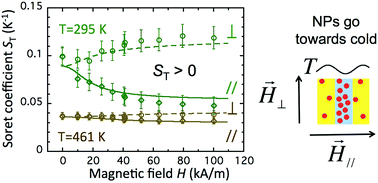Thermodiffusion anisotropy under a magnetic field in ionic liquid-based ferrofluids
Abstract
Ferrofluids based on maghemite nanoparticles (NPs), typically 10 nm in diameter, are dispersed in an ionic liquid (1-ethyl 3-methylimidazolium bistriflimide – EMIM-TFSI). The average interparticle interaction is found to be repulsive by small angle scattering of X-rays and of neutrons, with a second virial coefficient A2 = 7.3. A moderately concentrated sample at Φ = 5.95 vol% is probed by forced Rayleigh scattering under an applied magnetic field (up to H = 100 kA m−1) from room temperature up to T = 460 K. Irrespective of the values of H and T, the NPs in this study are always found to migrate towards the cold region. The in-field anisotropy of the mass diffusion coefficient Dm and that of the (always positive) Soret coefficient ST are well described by the presented model in the whole range of H and T. The main origin of anisotropy is the spatial inhomogeneities of concentration in the ferrofluid along the direction of the applied field. Since this effect originates from the magnetic dipolar interparticle interaction, the anisotropy of thermodiffusion progressively vanishes when temperature and thermal motion increase.



 Please wait while we load your content...
Please wait while we load your content...